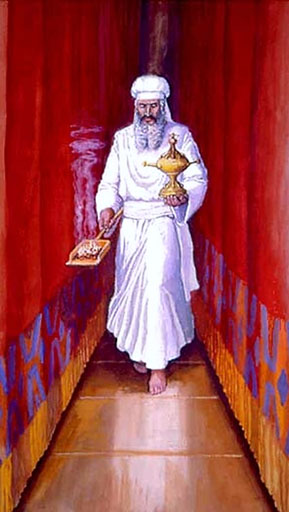
Ancient Israelite temple vestiture and ritual. The High Priest wears his special linen garments, sash and turban during his once per year entry into the Holy of Holies on Yom Kippur, the Day of Atonement. He approaches the Ark of the Covenant beyond the veil with the incense shovel in one hand, the smoke representing the prayers of the Israelites, and small vessel of bull’s blood in the other hand, the sin offering (atonement) on behalf of all the Israelites. Image based on Leviticus 16 and Exodus 25-31 and Exodus 35-40.
Professor William J. Hamblin has offered some good starting points in considering the relationship between the ancient Israelite temple ritual and the modern day LDS temple endowment. It is from this vantage point that we should approach trying to understand these ancient ritual systems and the connections they might have with the Latter-day Saints temple ritual.
“When considering the possible relationship between ancient Israelite temple system and the LDS Endowment, the first thing to note is the basic purpose of the ancient temple was to reconcile Israel with God and bring all Israel (represented by the twelve stones inscribed with the tribal names) back into the presence of God (that is recapitulating the Sinai theophany), symbolically represented by the Holy Place and Holy of Holies within the veil.
“The second thing to note is that Israel had exoteric rituals in the outer courtyard of the temple which could be witnessed by all (though only priests officiated). Esoteric rituals performed inside the temple itself could only be performed and witnessed by priests. LDS Endowment broadly corresponds to the esoteric rituals performed inside the temple, not the exoteric rituals performed outside. The ancient exoteric Israelite temple rituals correspond with the LDS weekly sacrament (the bread/wine offering of the Israelite temple).” (William Hamblin, Mormon Scripture Explorations)
Another important point to realize is that Christ was the last great blood sacrifice when He came in the meridian of time and offered the Atonement, which ended sacrifice by the shedding of blood (3 Ne. 9:19; cf. Mosiah 13:27; Alma 34:13; 3 Ne. 15:2–10). Since Christ was the last blood sacrifice (all precursors pointing to Him), from that point onward the outward nature of sacrificial ritual changed, but still pointing towards Christ, and still a sacrifice of a broken heart and contrite spirit (3 Ne. 9:20–22; Psalms 51:16–17; Psalms 34:18).
See the gallery below for various artists’ depictions of the rituals inside the ancient Israelite temple. Click each image to enlarge.















The Relationship between the Ancient Israelite Temple and the Endowment
Continue reading at the original source →



